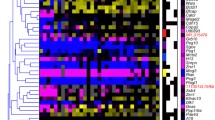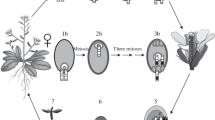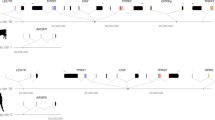Abstract
There are multiple theories on the evolution of genomic imprinting. We investigated whether the molecular evolution of true orthologs of known imprinted genes provides support for theories based on gene duplication or parental conflicts (where mediated by amino-acid changes). Our analysis of 34 orthologous genes demonstrates that the vast majority of mammalian imprinted genes have not undergone any subsequent significant gene duplication within placental species, suggesting that selection pressures against gene duplication events could be operating for imprinted loci. As antagonistic co-evolution between imprinted genes can regulate offspring growth, proteins mediating this interaction could be subject to rapid evolution via positive selection. Supporting this, we detect evidence of site specific positive selection for the imprinted genes OSBPL5 (and GNASXL), and detect lineage-specific positive selection for 14 imprinted genes where it is known that the gene is imprinted in a specific lineage, namely for: PLAGL1, IGF2, SLC22A18, OSBPL5, DCN, DLK1, RASGRF1, IGF2R, IMPACT, GRB10, NAPIL4, UBE3A, GATM and GABRG3. However, there is an overall lack of concordance between the known imprinting status of each gene (i.e. whether the gene is imprinted or biallelically expressed in a particular mammalian lineage) and positive selection. While only a small number of orthologs of imprinted loci display evidence of positive selection, we observe that the majority of orthologs of imprinted loci display high levels of micro-synteny conservation and have undergone very few cis- or trans-duplications in placental mammalian lineages.



Similar content being viewed by others
References
Altenhoff AM, Dessimoz C (2009) Phylogenetic and functional assessment of orthologs inference projects and methods. PLoS Comput Biol 5:e1000262
Chang BS, Campbell DL (2000) Bias in phylogenetic reconstruction of vertebrate rhodopsin sequences. Mol Biol Evol 17:1220–1231
Chenna R, Sugawara H, Koike T, Lopez R, Gibson TJ, Higgins DG, Thompson JD (2003) Multiple sequence alignment with the Clustal series of programs. Nucleic Acids Res 31:3497–3500
Edgar RC (2004) MUSCLE: a multiple sequence alignment method with reduced time and space complexity. BMC Bioinformatics 5:113
Foster PG, Jermiin LS, Hickey DA (1997) Nucleotide composition bias affects amino acid content in proteins coded by animal mitochondria. J Mol Evol 44:282–288
Garnier O, Laoueille-Duprat S, Spillane C (2008) Genomic imprinting in plants. Epigenetics 3:14–20
Glaser RL, Ramsay JP, Morison IM (2006) The imprinted gene and parent-of-origin effect database now includes parental origin of de novo mutations. Nucleic Acids Res 34:D29–D31
Greally JM (2002) Short interspersed transposable elements (SINEs) are excluded from imprinted regions in the human genome. Proc Natl Acad Sci USA 99:327–332
Haig D (2004) Genomic imprinting and kinship: how good is the evidence? Annu Rev Genet 38:553–585
Haig D (2006) Intragenomic politics. Cytogenet Genome Res 113:68–74
Haig D, Trivers R (1995) The evolution of parental imprinting: a review of hypotheses. In: Ohlsson R, Hall K, Ritzen M (eds) Genomic imprinting: causes and consequences. Cambridge University Press, Cambridge, pp 17–28
Hurst LD (1997) Evolutionary theories of genomic imprinting. In: Reik W, Surani A (eds) Genomic imprinting. IRL Press, Oxford, pp 211–237
Hurst LD, McVean GT (1998) Do we understand the evolution of genomic imprinting? Curr Opin Genet Dev 8:701–708
Hutter B, Bieg M, Helms V, Paulsen M (2010) Divergence of imprinted genes during mammalian evolution. BMC Evol Biol 10:116
Inagaki Y, Roger AJ (2006) Phylogenetic estimation under codon models can be biased by codon usage heterogeneity. Mol Phylogenet Evol 40:428–434
Iwasa Y (1998) The conflict theory of genomic imprinting: how much can be explained? Curr Top Dev Biol 40:255–293
Jones DT, Taylor WR, Thornton JM (1992) The rapid generation of mutation data matrices from protein sequences. Comput Appl Biosci 8:275–282
Keane TM, Naughton TJ, McInerney JO (2007) MultiPhyl: a high-throughput phylogenomics webserver using distributed computing. Nucleic Acids Res 35:W33–W37
Killian JK, Byrd JC, Jirtle JV, Munday BL, Stoskopf MK, MacDonald RG, Jirtle RL (2000) M6P/IGF2R imprinting evolution in mammals. Mol Cell 5:707–716
Kono T (2006) Genomic imprinting is a barrier to parthenogenesis in mammals. Cytogenet Genome Res 113:31–35
Kono T, Obata Y, Wu Q, Niwa K, Ono Y, Yamamoto Y, Park ES, Seo JS, Ogawa H (2004) Birth of parthenogenetic mice that can develop to adulthood. Nature 428:860–864
Kono T, Kawahara M, Wu Q, Hiura H, Obata Y (2006) Paternal dual barrier by Ifg2–H19 and Dlk1–Gtl2 to parthenogenesis in mice. Ernst Schering Res Found Workshop, pp 23–33
Kosiol C, Vinar T, da Fonseca RR, Hubisz MJ, Bustamante CD, Nielsen R, Siepel A (2008) Patterns of positive selection in six mammalian genomes. PLoS Genet 4:e1000144
Lawton BR, Carone BR, Obergfell CJ, Ferreri GC, Gondolphi CM, Vandeberg JL, Imumorin I, O’Neill RJ, O’Neill MJ (2008) Genomic imprinting of IGF2 in marsupials is methylation dependent. BMC Genomics 9:205
Lercher MJ, Hurst LD (2003) Imprinted chromosomal regions of the human genome have unusually high recombination rates. Genetics 165:1629–1632
Luedi PP, Dietrich FS, Weidman JR, Bosko JM, Jirtle RL, Hartemink AJ (2007) Computational and experimental identification of novel human imprinted genes. Genome Res 17:1723–1730
McVean GT, Hurst LD (1997) Molecular evolution of imprinted genes: no evidence for antagonistic coevolution. Proc Biol Sci 264:739–746
Moore T, Haig D (1991) Genomic imprinting in mammalian development: a parental tug-of-war. Trends Genet 7:45–49
O’Neill MJ, Lawton BR, Mateos M, Carone DM, Ferreri GC, Hrbek T, Meredith RW, Reznick DN, O’Neill RJ (2007) Ancient and continuing Darwinian selection on insulin-like growth factor II in placental fishes. Proc Natl Acad Sci USA 104:12404–12409
Okamura K, Yamada Y, Sakaki Y, Ito T (2004) An evolutionary scenario for genomic imprinting of Impact lying between nonimprinted neighbors. DNA Res 11:381–390
Page RD (1998) GeneTree: comparing gene and species phylogenies using reconciled trees. Bioinformatics 14:819–820
Pardo-Manuel de Villena F, de la Casa-Esperon E, Sapienza C (2000) Natural selection and the function of genome imprinting: beyond the silenced minority. Trends Genet 16:573–579
Parker-Katiraee L, Carson AR, Yamada T, Arnaud P, Feil R, Abu-Amero SN, Moore GE, Kaneda M, Perry GH, Stone AC, Lee C, Meguro-Horike M, Sasaki H, Kobayashi K, Nakabayashi K, Scherer SW (2007) Identification of the imprinted KLF14 transcription factor undergoing human-specific accelerated evolution. PLoS Genet 3:e65
Pask AJ, Papenfuss AT, Ager EI, McColl KA, Speed TP, Renfree MB (2009) Analysis of the platypus genome suggests a transposon origin for mammalian imprinting. Genome Biol 10:R1
Sandovici I, Kassovska-Bratinova S, Vaughan JE, Stewart R, Leppert M, Sapienza C (2006) Human imprinted chromosomal regions are historical hot-spots of recombination. PLoS Genet 2:e101
Schmidt HA, von Haeseler A (2007) Maximum-likelihood analysis using TREE-PUZZLE. Curr Protoc Bioinformatics, Chap 6, Unit 6 6
Schmidt HA, Strimmer K, Vingron M, von Haeseler A (2002) TREE-PUZZLE: maximum likelihood phylogenetic analysis using quartets and parallel computing. Bioinformatics 18:502–504
Smith NG, Hurst LD (1998) Molecular evolution of an imprinted gene: repeatability of patterns of evolution within the mammalian insulin-like growth factor type II receptor. Genetics 150:823–833
Spillane C, Schmid KJ, Laoueille-Duprat S, Pien S, Escobar-Restrepo JM, Baroux C, Gagliardini V, Page DR, Wolfe KH, Grossniklaus U (2007) Positive darwinian selection at the imprinted MEDEA locus in plants. Nature 448:349–352
Suchanek M, Hynynen R, Wohlfahrt G, Lehto M, Johansson M, Saarinen H, Radzikowska A, Thiele C, Olkkonen VM (2007) The mammalian oxysterol-binding protein-related proteins (ORPs) bind 25-hydroxycholesterol in an evolutionarily conserved pocket. Biochem J 405:473–480
Swanson WJ, Nielsen R, Yang Q (2003) Pervasive adaptive evolution in mammalian fertilization proteins. Mol Biol Evol 20:18–20
Varmuza S, Mann M (1994) Genomic imprinting-defusing the ovarian time bomb. Trends Genet 10:118–123
Varrault A, Gueydan C, Delalbre A, Bellmann A, Houssami S, Aknin C, Severac D, Chotard L, Kahli M, Le Digarcher A, Pavlidis P, Journot L (2006) Zac1 regulates an imprinted gene network critically involved in the control of embryonic growth. Dev Cell 11:711–722
Vilella AJ, Severin J, Ureta-Vidal A, Heng L, Durbin R, Birney E (2009) EnsemblCompara GeneTrees: complete, duplication-aware phylogenetic trees in vertebrates. Genome Res 19:327–335
Vu TH, Jirtle RL, Hoffman AR (2006) Cross-species clues of an epigenetic imprinting regulatory code for the IGF2R gene. Cytogenet Genome Res 113:202–208
Wadhawan S, Dickins B, Nekrutenko A (2008) Wheels within wheels: clues to the evolution of the Gnas and Gnal loci. Mol Biol Evol 25:2745–2757
Walter J, Paulsen M (2003) The potential role of gene duplications in the evolution of imprinting mechanisms. Hum Mol Genet 12(Spec no 2):R215–R220
Wang PY, Weng J, Lee S, Anderson RG (2008) The N terminus controls sterol binding while the C terminus regulates the scaffolding function of OSBP. J Biol Chem 283:8034–8045
Weidman JR, Murphy SK, Nolan CM, Dietrich FS, Jirtle RL (2004) Phylogenetic footprint analysis of IGF2 in extant mammals. Genome Res 14:1726–1732
Weidman JR, Dolinoy DC, Maloney KA, Cheng JF, Jirtle RL (2006a) Imprinting of opossum Igf2r in the absence of differential methylation and air. Epigenetics 1:49–54
Weidman JR, Maloney KA, Jirtle RL (2006b) Comparative phylogenetic analysis reveals multiple non-imprinted isoforms of opossum Dlk1. Mamm Genome 17:157–167
Wilkins JF, Haig D (2003) What good is genomic imprinting: the function of parent-specific gene expression. Nat Rev Genet 4:359–368
Wood AJ, Oakey RJ (2006) Genomic imprinting in mammals: emerging themes and established theories. PLoS Genet 2:e147
Yang Z (1997) PAML: a program package for phylogenetic analysis by maximum likelihood. Comput Appl Biosci 13:555–556
Yang Z (1998) Likelihood ratio tests for detecting positive selection and application to primate lysozyme evolution. Mol Biol Evol 15:568–573
Yang Z, Nielsen R (1998) Synonymous and nonsynonymous rate variation in nuclear genes of mammals. J Mol Evol 46:409–418
Yang Z, Wong WS, Nielsen R (2005) Bayes empirical bayes inference of amino acid sites under positive selection. Mol Biol Evol 22:1107–1118
Zhang J, Nielsen R, Yang Z (2005) Evaluation of an improved branch-site likelihood method for detecting positive selection at the molecular level. Mol Biol Evol 22:2472–2479
Acknowledgements
MD & NBL acknowledge funding support from IRCSET. TAW acknowledges funding support from the School of Biotechnology and the Pierse Trust DCU. We would like to thank the Science Foundation Ireland and the Higher Education Authority - Irish Centre for High-End Computing (ICHEC) for processor time and technical support. We are grateful to the comments of two anonymous reviewers on a previous draft of this paper. We would like to thank Dr James McInerney (NUIM, Ireland) and Prof Ken Wolfe (TCD, Ireland) for discussions relating to analysis and for computational facilities. CS and MJOC are funded by Science Foundation Ireland (Grants 08/IN.1/B1931 and EOB2673).
Conflict of interest
The authors declare no conflict of interest.
Author information
Authors and Affiliations
Corresponding authors
Additional information
Author contributions
M.J.O’C, K.J.S and C.S designed research; M.J.O’C, N.B.L, T.A.W. and M.T.A.D. performed research; M.T.A.D, M.J.O’C, N.B.L, T.A.W., and CS prepared Results Figures and Tables, and M.J.O’C and C.S wrote the paper.
Noeleen B. Loughran, Mark T.A. Donoghue contributed equally to this work.
Electronic supplementary material
Below is the link to the electronic supplementary material.
Supplementary File 6:
Reconciliation of gene and species trees for (a)GATM, (b)COPG2and (c)IMPACT. Gene duplication events for these genes within the imprinted clade are shown as large red circles on the node at which the duplication event/events occurred. The gene duplicate that has been retained is indicated in heavy black lines, while the duplicates that have been lost are shown as pale grey lines. (PDF 203 kb)
Rights and permissions
About this article
Cite this article
O’Connell, M.J., Loughran, N.B., Walsh, T.A. et al. A phylogenetic approach to test for evidence of parental conflict or gene duplications associated with protein-encoding imprinted orthologous genes in placental mammals. Mamm Genome 21, 486–498 (2010). https://doi.org/10.1007/s00335-010-9283-5
Received:
Accepted:
Published:
Issue Date:
DOI: https://doi.org/10.1007/s00335-010-9283-5




